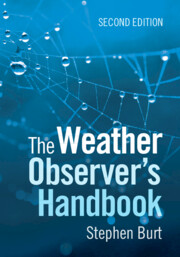Book contents
- The Weather Observer’s Handbook
- Reviews
- The Weather Observer’s Handbook
- Copyright page
- Dedication
- Epigraph
- Contents
- Foreword
- Acknowledgements
- Author’s note
- Abbreviations, footnotes and references
- Part I The basics
- Part II Measuring the weather
- 4 Site and exposure: The basics
- 5 Measuring the temperature of the air
- 6 Measuring precipitation
- 7 Measuring atmospheric pressure
- 8 Measuring humidity
- 9 Measuring wind speed and direction
- 10 Measuring grass and earth temperatures
- 11 Measuring sunshine and solar radiation
- 12 Observing hours and time standards
- 13 AWS data flows, display and storage
- 14 Non-instrumental weather observing
- 15 Calibration
- 16 Metadata: What is it, and why is it important?
- Part III Making the most of your observations
- Book part
- References and Further Reading
- Index
11 - Measuring sunshine and solar radiation
from Part II - Measuring the weather
Published online by Cambridge University Press: 21 May 2024
- The Weather Observer’s Handbook
- Reviews
- The Weather Observer’s Handbook
- Copyright page
- Dedication
- Epigraph
- Contents
- Foreword
- Acknowledgements
- Author’s note
- Abbreviations, footnotes and references
- Part I The basics
- Part II Measuring the weather
- 4 Site and exposure: The basics
- 5 Measuring the temperature of the air
- 6 Measuring precipitation
- 7 Measuring atmospheric pressure
- 8 Measuring humidity
- 9 Measuring wind speed and direction
- 10 Measuring grass and earth temperatures
- 11 Measuring sunshine and solar radiation
- 12 Observing hours and time standards
- 13 AWS data flows, display and storage
- 14 Non-instrumental weather observing
- 15 Calibration
- 16 Metadata: What is it, and why is it important?
- Part III Making the most of your observations
- Book part
- References and Further Reading
- Index
Summary
In order to provide representative measurements of solar radiation and sunshine duration, measuring devices must be deployed in suitable locations or sites and the instruments themselves exposed to the sky in a standardised manner. This chapter sets out what those standardised conditions of site and exposure are for measurements of solar radiation (direct, global and diffuse solar radiation) and sunshine duration, following guidelines laid down by the World Meteorological Organization in the so-called CIMO guide (Commission for Instruments and Methods of Observation). Suitably exposed sites can be difficult to find, and unlike other meteorological instruments a mast or rooftop exposure may be ideal. Various instruments have been developed to measure sunshine over the past two centuries, including a variety of recent electronic sensors, but exact agreement between different sensors with varying methods of operation has proved problematic, and the implications for long-period sunshine records are discussed.
Keywords
- Type
- Chapter
- Information
- The Weather Observer's Handbook , pp. 263 - 302Publisher: Cambridge University PressPrint publication year: 2024

